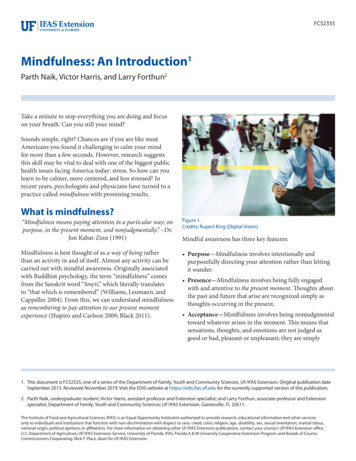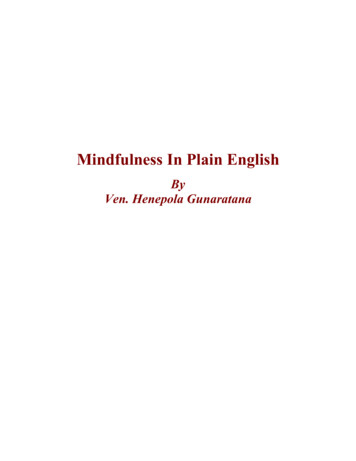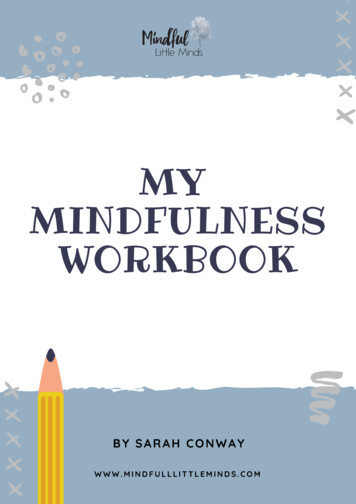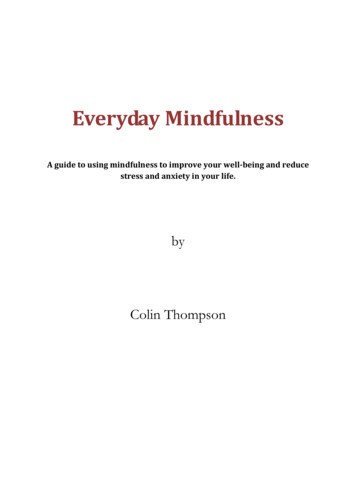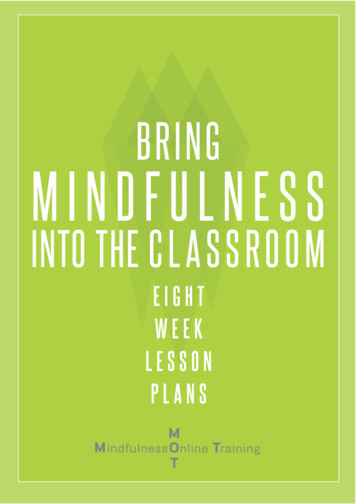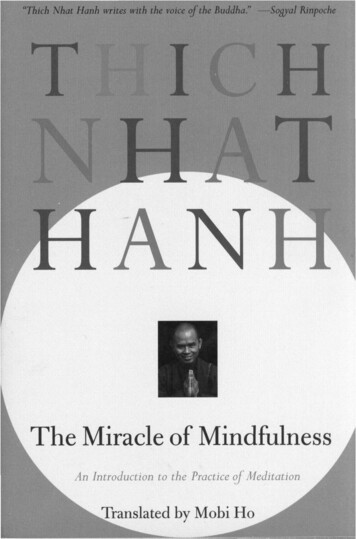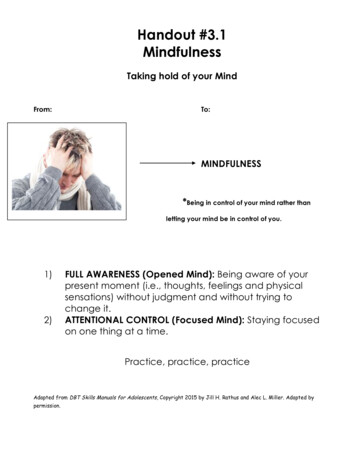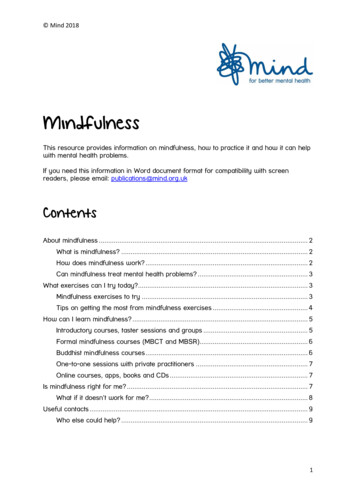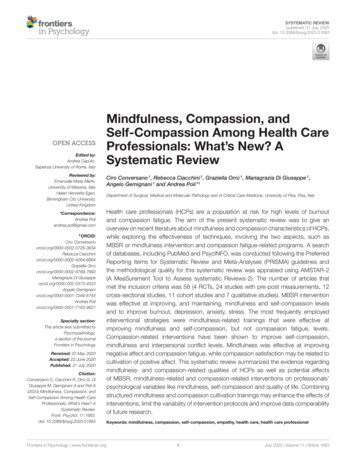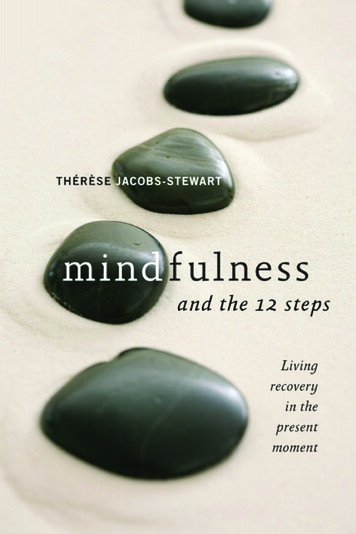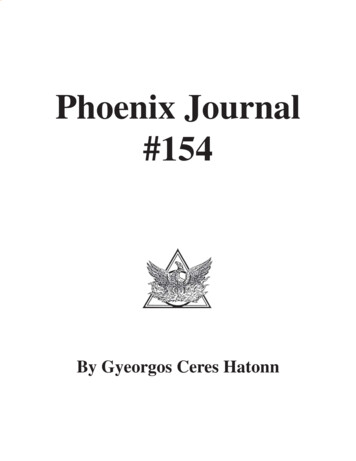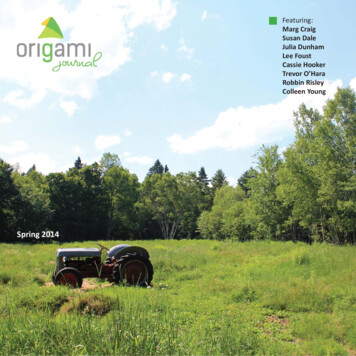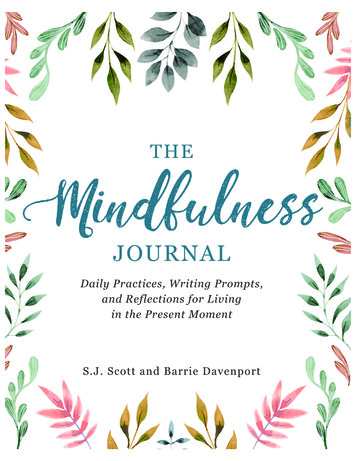
Transcription
Why Mindfulness?“Mindfulness is the aware, balanced acceptance of the presentexperience. It isn’t more complicated than that. It is openingto or receiving the present moment, pleasant or unpleasant,just as it is, without either clinging to it or rejecting it.”Sylvia BoorsteinThe concept of mindfulness is very simple.When you are mindful, you are intentionally aware of the present moment. Youconsciously direct your awareness to whatever you are doing, thinking, or observing.Making tea.Looking out the window.Having a conversation.Folding laundry.Working on a project.Exercising.Journaling.
In addition to being purposefully aware, there is another element of mindfulness—the practice of non-judgment.Non-judgment means you observe your experiences, thoughts, and feelings froma distance, without labeling them as good or bad, right or wrong. This detachmentfrom judging the moment but simply experiencing it removes the filter of appraisal,which pulls us away from the actual experience.Left to its own devices, the brain automatically judges things as right or wrong,good or bad, useful or not useful, and so on. This judgment occurs so quickly thatour moments are tainted by our thoughts about them before we can fully processthe experience.Adding non-judgmental awareness to your mindfulness practice helps removethese filters so you can fully and authentically experience the moment. In addition,our judgments about our thoughts often cause us unnecessary anxiety. Avoidingthis suffering is another compelling reason to leave judgments by the wayside.At first, it will be hard to be a detached observer of your experiences, and simplyexperience them. But the more you practice mindfulness in daily life, the moreadept you become at living purely in the now.You might wonder why you should bother with this practice at all. Why do youneed mindfulness in your life?As we say in our book, 10-Minute Mindfulness, “For those who are frequentlypulled away by the usual preoccupations of daily living (and isn’t that most of us?),mindfulness affords a richer appreciation of the moment and a larger perspectiveon life. It also helps us alter our habitual responses by pausing long enough tochoose how we act.”
Being more intentional in our choices is reason enough to embrace mindfulnesshabits. But science has confirmed there are many additional physical and emotionalbenefits. Mindfulness practices have been researched extensively, and shown to:Reduce rumination and overthinking.Decrease stress by lowering levels of the stress hormone cortisol.Improve memory, concentration, and performance.Help maintain emotional stability.Improve relationship happiness.Reduce symptoms of anxiety and depression.Improve sleep.Protect against mental illness.Provide pain relief.With the repetition of mindfulness activities, you will create real changes inyour brain function and structure. Just as exercise habits will change your body,mindfulness habits will literally reshape your mind.
P R A CTI C IN GMindfulness Daily“In this moment, there is plenty of time.In this moment, you are precisely as you should be.In this moment, there is infinite possibility.”Victoria MoranThe skills involved in mindfulness aren’t brain surgery, but the practice itself isharder than you might think. The ability to incorporate mindfulness into our dailylives is something that requires daily awareness. You first have to remember to doit, and then you need to create strategies for incorporating this practice into yourdaily routine.That’s where this journal comes in.The practice of journaling is an excellent mindfulness practice itself, because youare encouraging your mind to be present with your writing. It forces your brain toslow down to better organize your thoughts and consider the big picture.
With The Mindfulness Journal, you’ll get a double dose of daily mindfulness—through the mindfulness activity outlined in the daily prompts, as well as your timespent journaling about the activity.Writing about your experiences with mindfulness will help you master the practice,reflect on your thoughts and experiences, and provide a permanent record of yourefforts at deepening the amount of purposeful intention in your life.Most of the mindfulness practices we provide take very little time—most require10 minutes of effort on your part. Then you will spend a few minutes writing aboutyour experience with the practice. Sometimes you may only write a few sentences.Other times you’ll be inspired or invited to write more.You will need to set aside time during your day to both work on the mindfulnesspractice and journal about it.
HO W TO USET he Mindfulness Journal“There is something about journal writing that causesus to meditate, to recommit, and to receive spiritualimpressions in the process of such pondering.”L. Edward BrownThis journal provides a total of 365 daily writing prompts divided into 52 weeklymindfulness topics. This arrangement gives you seven days to immerse yourself ineach topic. It is designed to awaken you to mindfulness in various natural momentsthroughout your day, as well as with some activities that may be new for you.This will be a process of self-discovery as you try various ways to practice mindfulnessand write about your experiences. It will help you discover what specific activitieswork best for you and your lifestyle. We invite you to keep your mind and heartopen, even if some of the practices seem strange or simplistic. There is a purposebehind each topic, activity, and related prompt.The practices presented in some of the writing prompts require little more thanthought and reflection. Others require performing a specific action or series ofactions, either in the moment or during your day. Some journal topics are moresuited to morning action and writing, while others are better for evening or rightbefore you go to bed.
For this reason, we suggest you read through the weekly topic and related journalprompts before you begin each week. This will help determine the best time of dayto practice the mindfulness habits, and when to write about them.We encourage you to journal about your mindfulness habit as soon as possibleafter you practice it, so that your feelings and reactions are fresh on your mind.Because you will be practicing and writing at different times during the day, youmay find it harder to stick to your journaling habit if you need a regular routine.You may find you need to commit to a specific time that is consistent day after dayto work through this journal. If this is the case for you, skip any weeks that requireyou to change your journaling time, and save them for later when you have morefully established the habit of working on this journal.You don’t need to follow the weekly order of topics the way they are presentedhere. You can move from Week 1 to Week 32, then back to Week 5 if you wish,depending on what you wish to focus on. It is helpful to work the full seven daysof topic-related activities so you can delve into each topic. But it is also fine if youwant to randomly choose a different prompt from a different topic every day. Thisis your journal, after all, so use it in the way that feels best for you and your goals.“A blank page is no empty space. It is brimming with potential.It is a masterpiece in waiting—yours.”A.A. Patawaran
WE EK 1Daily Gratitude“When you arise in the morning, think of what aprecious privilege it is to be alive—to breathe, to think, to enjoy, to love.”Marcus AureliusBuddhist monks start the day with chants of gratitude for their blessings. NativeAmerican elders begin their ceremonies with prayers of gratitude to mother earthand father sky, to the four directions, to the animal, plant, and mineral brothersand sisters who share our earth and support our life. Tibetan monks and nunsoffer prayers of gratitude for the suffering they have been given, saying, “Grantthat I might have enough suffering to awaken in the deepest possible compassionand wisdom.”Gratitude is a mindfulness practice that opens you to joy, compassion, andappreciation of the life that sustains you. Begin your morning with awarenessthat you have awakened to a new day, a blank page full of promise and potential.Before you begin your morning routine, take a deep breath, close your eyes, andfocus on all you are grateful for in your life based on the daily prompt.Best time to journal:morning
Day 1I reflect on the people in my life who have made me feel loved andsupported. I feel grateful for
Day 2I am mindful of the strengths, skills, and aptitudes I possess thathave helped me become who I am. I feel grateful for
Day 3I remember all the mentors who have shown me the wayand inspired me. I feel grateful for
Day 4I am mindful of the home I live in and how it provides a safe andpeaceful haven for me and my family. I feel grateful for
Day 5I consider the work I do in a career or at home, and how it impactsmy life and well-being. I feel grateful for
Day 6I am mindful of the beauty of nature, of all living creatures,and the world around me. I feel grateful for
Day 7I reflect on all of the lessons I have learned in life so far, andhow they have helped me grow and evolve. I feel grateful for
W EEK 2Body Awareness“Attention to the human body brings healing andregeneration. Through awareness of the body weremember who we really are.”Jack KornfieldMost mindfulness practices begin with your body by drawing your attention toyour breath and the quality of sensation. In ancient Buddhist teachings of “TheFour Foundations of Mindfulness,” the first teaching is “mindfulness of thebody,” which involves becoming familiar with and even loving the body. Bodymindfulness anchors you in the here and now.Your body can reveal so much about your inner world if you pay attention toit. Every tight muscle, aching joint, and anxious breath gives you a clue to theworries and challenges you carry inside of you. Through body awareness, youhave the power to release both the physical and mental distress, as you breatherelaxation and healing into each part of your body.Best time to journal:anytime
Day 1I visualize a bright and healing beam of light flowing down from thesky, through the top of my head, filling my body with energy andgrounding me to the earth. My body responds by
Day 2I scan my body for any aches, pains, or tension. I notice these feelingsand how I might be resisting them. What are these aches and painstelling me about any mental distress or behavior changes I need tomake? What mental resistance to these feelings do I need to drop?
Day 3I am mindful of the ways my body causes me shame, embarrassment,or unhappiness. How often do I focus on what I hate about my body?How can I show my body more compassion? Today I will writea letter of love and gratitude to my body.
Day 4As I sit quietly, I notice each breath I take, following the intake of airthrough my nose and into my lungs, and the slow exhalation as Irelease the air through my nose. As I repeat this mindfulbreathing for several minutes, I notice my body
Day 5I take a few deep breaths and focus attention on my energy level inmy body. Do I feel tired, restless, sleepy, or depleted, or am Ienergized and invigorated? My energy level is telling me
Day 6I focus on all of the organs, muscles, and bones in my body and whattheir purpose is for my health, sustenance, movement, and sensations.As I focus my attention on these parts of my body, I feel
Day 7I sit quietly, take a few deep and cleansing breaths, and perform arelaxation body scan. Starting at my toes, I focus attention on eachpart of my body, breathing relaxation into each area. I move from mytoes upward, relaxing each body part until I reach the top of my head.My body responds by
through the mindfulness activity outlined in the daily prompts, as well as your time spent journaling about the activity. Writing about your experiences with mindfulness will help you master the practice, reect on your thoughts and experiences, and provide a permanent record of your eorts at deepening the amount of purposeful intention in your life. Most of the mindfulness practices we provide .
